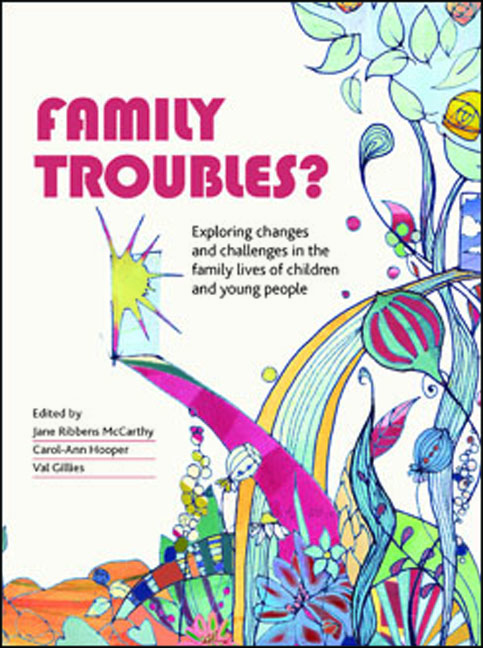Book contents
- Frontmatter
- Contents
- Notes on contributors
- Foreword
- Preface
- 1 Troubling normalities and normal family troubles: diversities, experiences and tensions
- Part One Approaching family troubles ? Contexts and methodologies :Introduction to Part One
- Part Two Whose trouble ? Conteste d definitions and practice: Introduction to Part Two
- Part Three The Normal, The Troubling And The Harmful?: Introduction to Part Three
- Part Four Troubles and transitions across space and culture: Introduction to Part Four
- Part Five Working With Families: Introduction to Part Five
- Index
10 - Revealing the lived reality of kinship care through children and young people's narratives: “It's not all nice, it's not all easy-going, it's a difficult journey to go on”
Published online by Cambridge University Press: 07 September 2022
- Frontmatter
- Contents
- Notes on contributors
- Foreword
- Preface
- 1 Troubling normalities and normal family troubles: diversities, experiences and tensions
- Part One Approaching family troubles ? Contexts and methodologies :Introduction to Part One
- Part Two Whose trouble ? Conteste d definitions and practice: Introduction to Part Two
- Part Three The Normal, The Troubling And The Harmful?: Introduction to Part Three
- Part Four Troubles and transitions across space and culture: Introduction to Part Four
- Part Five Working With Families: Introduction to Part Five
- Index
Summary
Introduction
This chapter examines kinship carers’ own children's experiences of the kinship care arrangement (also known as family and friends care). The research emanated from the author's professional role as a kinship social worker and the identified invisibility of kinship carers’ own children within research and social work policy and practice. The research was underpinned by the sociology of childhood and informed by a children's rights framework, which viewed children as social actors and active participants within the research. The aim of the study was to illuminate the positions and perspectives of kinship carers’ own children through multiple narratives. Illustrative data are drawn from a qualitative doctoral study. The research consisted of seven kinship care families, involving semi-structured interviews with eight kinship carers, ten kinship carers’ own children and seven placed children aged between three and 21 years old. Data were gathered using art, photo elicitation and audio research techniques and involved individual, dyad and family group interviews. Data also consisted of four focus groups and individual semi-structured interviews with a total of 35 social workers.
Social workers’ narratives were set against a pro-family legislative backdrop and child welfare policy context that seeks permanency for children who can no longer reside with their birth parents. The use of kinship care is reflected in the duty to place children with a relative or family friend contained within the Children Act 1989, a requirement strengthened through changes under the Adoption and Children Act 2002, Public Law Outline 2008 and the replacement of section 23 of the Children Act 1989 by the insertion of section 22(C) of the Children and Young Persons Act 2008. Herein, preference must be given to placing a child with a relative, friend or other connected person who can safeguard and promote their welfare. However, as explored later, this pro-family rhetoric was, at times, contested by the voices of kinship carers’ own children as a perspective that did not always reflect their lived experiences.
- Type
- Chapter
- Information
- Family Troubles?Exploring Changes and Challenges in the Family Lives of Children and Young People, pp. 119 - 130Publisher: Bristol University PressPrint publication year: 2013

